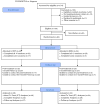Randomized trial of group cognitive behavioral therapy compared with a pain education control for low-literacy rural people with chronic pain
- PMID: 21920668
- PMCID: PMC3215913
- DOI: 10.1016/j.pain.2011.07.007
Randomized trial of group cognitive behavioral therapy compared with a pain education control for low-literacy rural people with chronic pain
Abstract
Chronic pain is a common and costly experience. Cognitive behavioral therapies (CBT) are efficacious for an array of chronic pain conditions. However, the literature is based primarily on urban (white) samples. It is unknown whether CBT works in low-socioeconomic status (SES) minority and nonminority groups. To address this question, we conducted a randomized controlled trial within a low-SES, rural chronic pain population. Specifically, we examined the feasibility, tolerability, acceptability, and efficacy of group CBT compared with a group education intervention (EDU). We hypothesized that although both interventions would elicit short- and long-term improvement across pain-related outcomes, the cognitively-focused CBT protocol would uniquely influence pain catastrophizing. Mixed design analyses of variance were conducted on the sample of eligible participants who did not commence treatment (N=26), the intention-to-treat sample (ITT; N=83), and the completer sample (N=61). Factors associated with treatment completion were examined. Results indicated significantly more drop-outs occurred in CBT. ITT analyses showed that participants in both conditions reported significant improvement across pain-related outcomes, and a nonsignificant trend was found for depressed mood to improve more in CBT than EDU. Results of the completer analyses produced a similar pattern of findings; however, CBT produced greater gains on cognitive and affect variables than EDU. Treatment gains were maintained at 6-month follow-up (N=54). Clinical significance of the findings and the number of treatment responders is reported. Overall, these findings indicate that CBT and EDU are viable treatment options in low-SES minority and nonminority groups. Further research should target disseminating and sustaining psychosocial treatment options within underserved populations.
Copyright © 2011 International Association for the Study of Pain. All rights reserved.
Conflict of interest statement
The authors have no conflicts of interest to report.
Figures
Comment in
-
Addressing literacy as a barrier in delivery and evaluation of cognitive-behavioral therapy for pain management.Pain. 2011 Dec;152(12):2679-2680. doi: 10.1016/j.pain.2011.09.004. Epub 2011 Sep 29. Pain. 2011. PMID: 21963312 No abstract available.
References
-
- Addis ME, Hatgis C, Bourne L, Krasnow AD, Jacob K, Mansfield A. Effectiveness of cognitive-behavioral treatment for panic disorder versus treatment as usual in a managed care setting. Journal of Consulting and Clinical Psychology. 2004;72:625–635. - PubMed
-
- All AC, Fried JH, Wallace DC. Quality of life, chronic pain, and issues for health care professionals in rural communities. Online Journal of Rural Nursing and Health Care. 2000;1:19–34.
-
- American Chronic Pain Association (ACPA) Partners for understanding pain. 2005 http://www.theacpa.org/pu_main_03.asp. retrieved December 7, 2005.
-
- Astin JA, Beckner W, Soeken K, Hochberg MC, Berman B. Psychological interventions for rheumatoid arthritis: a metaanalysis of randomized controlled trials. Arthritis & Rheumatism. 2002;47:291–302. - PubMed
-
- Attkisson C, Greenfield T. Instruments for Adults. Lawrence Erlbaum Associates Publishers; 2004. The UCSF Client Satisfaction Scales: The Client Satisfaction Scale-8.


